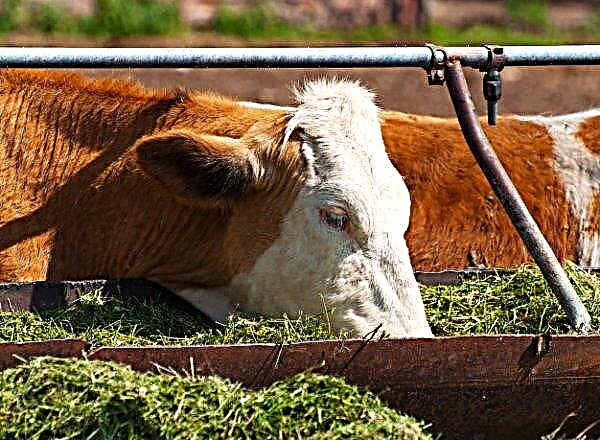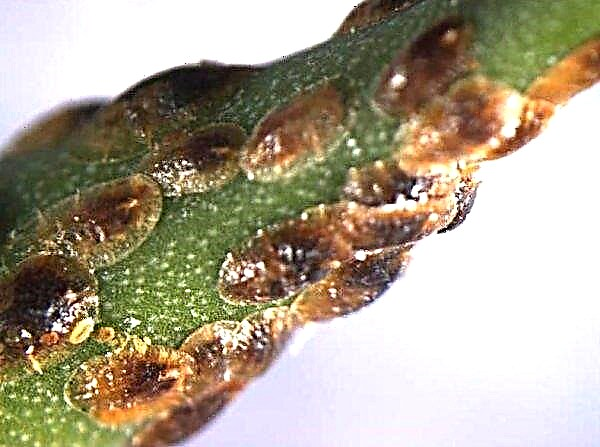Body temperature is one of the most important indicators that are used for a comprehensive assessment of the state of the body of both humans and animals. Its diverse ranges may indicate the development of complex lesions of the body, including those associated with all kinds of chronic diseases.
At the same time, not many pastoralists have the necessary level of knowledge and skills that make it possible to independently determine the pathology, as well as instantly eliminate its manifestations. You should consider this issue in detail, as well as tell the main causes of fever in cattle.
What is the normal temperature in cattle
Most farmers rarely resort to measuring the body temperature of animals in their own households. Thanks to the natural selection and careful work of breeders, modern agricultural species are resistant to many diseases, as well as infectious lesions.
That is why, subject to all modern cattle breeding standards, animals in a herd are rarely ill. However, livestock body temperature should be measured regularly, which in combination with frequent inspection of the whole body is the key to good health for each individual. Like all warm-blooded animals, the temperature of the body of healthy livestock has a strict framework, the excess of which indicates the development of various pathological processes. At the same time, due to the physiological characteristics of the organism, all artiodactyls have distinct temperature faces and are relatively age-related.
Like all warm-blooded animals, the temperature of the body of healthy livestock has a strict framework, the excess of which indicates the development of various pathological processes. At the same time, due to the physiological characteristics of the organism, all artiodactyls have distinct temperature faces and are relatively age-related.
Therefore, to determine whether a cow’s body temperature is elevated, it is imperative to study all available information about it, including the approximate age.
Physiological norms of cattle body temperature
| Type of cattle | Average, ° С |
| Newborn Calf (up to 2 weeks) | 38,5—40 |
| Calf 3-12 months old | 38,5—39,5 |
| Adult cow or bull (1 year and older) | 37,5—39 |
Important! If the temperature indicators described above are exceeded by 1 ° C or higher, you should definitely contact your veterinarian, otherwise there is a high probability of not noticing the first signs of complex diseases.
Physiological norms of pulse and respiratory movements in Cattle
| Type of cattle | Respiratory rate per minute | Pulse, bpm |
| Newborn Calf (up to 2 weeks) | 30—50 | 100—140 |
| Calf 3-12 months old | 25—45 | 70—100 |
| Adult cow or bull (1 year and older) | 15—25 | 50—75 |
How to measure temperature
Both at home and in the conditions of a veterinary clinic, the measurement of this indicator is carried out using the same method. To do this, use the so-called rectal method, which involves the introduction of a measuring device into the cavity of the rectum. It is not possible to measure the temperature in any other way in animals, since this violates the general safety rules, not only for humans, but also for livestock. Only two measuring devices are known:
Only two measuring devices are known:
- mercury thermometers - a glass hermetic device containing mercury compounds. When it comes in contact with the body, mercury expands in a vertical plane on a certain scale, which is responsible for temperature indicators;
- electronic device - an electrical device that calculates body temperature by measuring the resistance of a conductor that occurs when the indicator is heated.
Did you know? The creator of a mercury thermometer is considered to be Galileo Galilei. This famous Italian scientist and naturalist created a similar to modern mercury device back in 1506, on the basis of research by the Greek scientist Heron of Alexandria.
Today, both of these devices are widely used in veterinary practice, but most professional veterinarians prefer electronic thermometers. Despite the high cost, they can instantly determine the exact temperature indicators, and are also absolutely safe for mechanical damage to living things and the environment.  Regardless of the type of measuring device, the determination of temperature indicators in animals is carried out according to a single principle. They are divided into the following stages:
Regardless of the type of measuring device, the determination of temperature indicators in animals is carried out according to a single principle. They are divided into the following stages:
- Thermometer disinfection - for this, it is thoroughly wiped with sterile cotton wool moistened with 70% alcohol solution.
- Device lubrication - necessary to avoid excessive irritation of the rectum. A thermometer is often lubricated with petroleum jelly or another interchangeable, safe lubricant.
- Enter indicator into the body - a lubricated device is inserted into the rectum to a depth of 2-3 cm, with the measuring element inward.
- Thermometer exposure - necessary for the device to determine the actual temperature. For this, a mercury thermometer introduced into the rectum is held for 6-8 minutes, electronic - no more than 1 minute.
- Removing and cleaning the measuring device - after determining the temperature indicators, the device is slowly removed from the rectum, and then cleaned of physiological fluids and grease using a soap solution. After that, it is disinfected with a 70% alcohol solution.
Important! Measurement of body temperature often causes discomfort in livestock, to which animals can react sharply. The poetwhen carrying out the procedure, one must adhere to the general rules of safe behavior with cattle.
Why is it elevated
There may be several reasons for the increase in body temperature (hyperthermia) in animals. Most often, this process is associated with the development of various diseases in livestock, including extremely dangerous ones, which can lead to the death of the entire livestock.
But, sometimes this process can indicate problems in caring for animals. In this case, a change in temperature indicators occurs spontaneously, and is also not accompanied by additional symptoms.
Poisoning
Domestic artiodactyls are not able to determine the quality of those foods that they eat, so often enough cattle is poisoned by all kinds of toxic substances. They get into the feed as a result of spraying chemical protection products and fertilizers in grazing areas, but can also be the result of the ability of plants to accumulate and transform all kinds of poisons in themselves. It is not difficult to identify the development of this process, with poisoning, hyperthermia is accompanied by the following symptoms:
It is not difficult to identify the development of this process, with poisoning, hyperthermia is accompanied by the following symptoms:
- diarrhea;
- general oppression;
- cramps
- problems with movement (limb failure);
- a sharp change in behavior.
Important! Most often, livestock is poisoned by potatoes that have turned green in the sun, therefore, after long-term storage, the vegetable is strongly not recommended for feeding domestic animals.
Infectious diseases
The main reasons for the development of elevated body temperature in cattle is usually attributed to the development of various infectious lesions. Often this physiological syndrome occurs due to the penetration of dangerous viruses or bacteria into the body.
In this case, hyperthermia is a reaction of the immune system to foreign inclusions or signals the development of inflammatory processes. Most often, infections are accompanied by additional specific symptoms, manifested against the background of general inhibition of the animal. The most common diseases of livestock that cause a thermal reaction of the body are:
The most common diseases of livestock that cause a thermal reaction of the body are:
- leukemia;
- plague;
- pneumonia;
- leptospirosis;
- endometritis;
- mastitis;
- foot and mouth disease;
- brucellosis.
Poor nutrition
A sharp increase in temperature can also indicate poor or bacteria-infected feed. Such problems arise in most households that save on feed to increase the profitability of livestock.
In this case, the pathology develops as a reaction to the introduction of rotten bacteria or pathogenic fungi into the body. Often such processes are accompanied by an upset digestion, but unlike poisoning, they do not lead to fatal consequences.
How to knock down
After the main cause of hyperthermia has been identified, they begin to immediately eliminate this pathological process. Such treatment often takes place in a complex, so often animals are prescribed antibiotic, immunomodulatory or hormonal drugs.
The choice of the necessary remedy is made by the veterinarian on the basis of the main diagnosis, which is determined using a comprehensive diagnosis. When such treatment does not bring an instant decrease in temperature, animals are prescribed antipyretic drugs.
Did you know? Among the warm-blooded inhabitants of the planet, feathered are distinguished by the highest body temperature. In pigeons, chickens, and some small species of birds, this indicator is in the range from 40 to 43 ° C.
The most affordable and sought-after among many veterinarians is considered to be:
- antipyrine - a comprehensive veterinary medicine, close in nature to salicylic acid compounds. The drug is administered to animals orally, at the rate of 10-15 g / individual per day. The duration of treatment is determined by the veterinarian, depending on the condition of the animal;
- penicillin - a synthetic analogue of natural antibiotics produced by fungi of the genus Penicillium. It is a sodium salt of benzylpenicillin. Enter it intramuscularly, 4-6 times a day. The optimal single dose of the drug is 3-5 thousand units / kg of animal body weight. The duration of therapy depends on the state of the animal;
- polyflex - veterinary analogue of ampicillin preparations. The drug is administered intramuscularly, 1 time per day, at a dosage of 6-12 mg / kg of the animal’s weight. The duration of therapy depends on the general condition of the animal.
 Body temperature is one of the most important indicators, which even without a special veterinary education makes it possible to determine the general health status of farm animals. This process is quite dangerous for the body, as if untimely treatment can lead to cattle death.
Body temperature is one of the most important indicators, which even without a special veterinary education makes it possible to determine the general health status of farm animals. This process is quite dangerous for the body, as if untimely treatment can lead to cattle death.Therefore, when detecting an elevated temperature, all kinds of antipyretic drugs are shown to animals, however, such therapy should be necessarily controlled by an experienced and qualified veterinarian.












